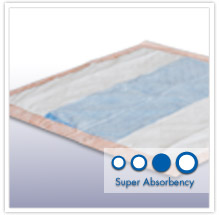
|
Six Steps to Pressure Ulcer Prevention
Pressure ulcers are a painful and costly problem in long-term care. They can also cause a great deal of harm to residents by hindering functional recovery, making individuals more likely to develop serious infections, increasing length of stay and raising the risk of mortality.
The good news is that there are a number of simple steps that can be taken to decrease the risk of pressure ulcer development. There are two key goals that you should strive to meet with your own pressure ulcer prevention plan: identifying at-risk residents and implementing prevention strategies for residents who are identified as being at risk.
|
The Institute for Healthcare Improvement (IHI) recommends implementing the following six pressure ulcer prevention strategies1:
- Conduct pressure ulcer admission assessments for all residents (including both a risk assessment and a skin assessment). Key factors that contribute to pressure ulcer development include age, incontinence, inadequate nutrition, sensory deficiency, device-related pressure, multiple comorbidities, circulatory abnormalities and dehydration.
- Reassess risk for all residents on a daily basis. Changes in mobility, incontinence and nutrition can impact a resident's risk of developing a pressure ulcer.
- Inspect skin daily. Pay special attention to areas that are at a high risk of pressure ulcer development, including the sacrum, back, buttocks, heels, elbows and any areas that are subjected to device-related pressure.
- Keep residents dry and moisturize their skin. Wet skin is more prone to developing rashes, is softer and tends to break down more easily. Be sure to provide underpads that pull moisture away from the skin as well as pre-moistened disposable barrier wipes that help cleanse, moisturize, deodorize and protect residents from incontinence-related dermatitis.
- Optimize nutrition and hydration. Edema and reduced blood flow to the skin are common with nutrition deficits and fluid imbalance. This can contribute to skin breakdown.
- Minimize pressure. Every effort should be made to redistribute pressure, either by repositioning the resident or utilizing pressure-redistribution surfaces.
To learn more about the IHI’s recommendations, click here*.
*registration required
|

|
 
|
Join Us for Our March Perfect Survey Webinar!
You know your problems. What you need are solutions. When you join us for a free tour of Compliance Solutions: For the Perfect Survey Every Day, you'll see that when it comes to survey preparation, you don't need another program, piece of software or consultant telling you where your problems lie. You need proven solutions to those problems.
During these monthly webinars, our Vice President of Clinical and Regulatory Compliance, Pam West, guides attendees through the contents of our exclusive online survey preparation tool, including:
- The actual forms that surveyors use
- Guidance broken down by F tag and care area
- Exclusive tips from industry veterans
- Case studies to address how you would handle specific challenges in your own facility
|
Whether you're a registered Perfect Survey user or just interested in learning more, this webinar will put you on the road to your own perfect survey!
Our next webinar will be held on March 15 from 11:30 a.m. – 12:30 p.m. CST.
|
 |


|
Embrace™ Underpads with Acquisition Layer & Odor Control
Our super-absorbency polymer underpads feature an acquisition layer to quickly wick moisture and lock it away from the skin, lowering the risk of skin breakdown. The polymers also feature a fresh scent to help control odors and promote resident dignity.
Additional Features:
- Dry-Dignity™ Acquisition Zone prevents leakage by channeling the void more evenly throughout the pad for higher absorbency
- Breathable Dry-Dignity™ Fabric helps prevent skin irritation by increasing air circulation
|
Product pricing is only visible to registered promedsupply.com customers. If you are not yet registered, give us a call at (800) 648-5190 and our Customer Care Professionals will be happy to get you set up.
|
|






